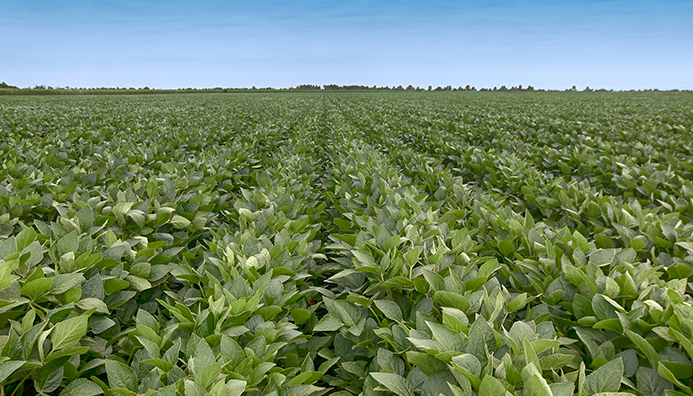Early-season broadleaf weed competition is one of the most significant threats to Canadian soybean fields, emerging weeds can quickly outcompete young soybean crops for light, water and nutrients. Left unmanaged, these weeds can cause substantial yield losses, reduce crop quality, and complicate harvest operations.
To protect soybean yields, it is crucial to identify key broadleaf weed species early and implement an integrated weed management strategy.
The Importance of Early-Season Weed Control
In soybeans, the first four to six weeks after emergence are the most critical for weed management. During this period, competition from broadleaf weeds can severely impact yield potential, with research indicating that soybean yield losses can exceed 50% if early-season weeds are not controlled.
Weeds that emerge before or simultaneously with soybeans are particularly damaging, as they can quickly establish dominance in the field. A well-planned herbicide program combined with cultural and mechanical control measures is essential to maintaining clean fields throughout the season.
Identifying Key Broadleaf Weed Species in Canadian Soybean Fields
Canadian soybean growers face competition from several broadleaf weed species, each with unique growth habits, resistance challenges, and management considerations. The following are some of the most common early-season broadleaf weeds found in Canadian soybean fields:
1. Canada Fleabane (Conyza canadensis)
- Germination Period: Can emerge in fall or early spring.
- Competitive Threat: Highly competitive due to its rapid growth and prolific seed production.
- Herbicide Resistance: Many populations are resistant to glyphosate and Group 2 herbicides.
2. Common Ragweed (Ambrosia artemisiifolia)
- Germination Period: Early spring, often emerging before soybeans.
- Competitive Threat: Can reduce soybean yields by up to 30% in dense infestations.
- Herbicide Resistance: Increasing resistance to Group 2 and glyphosate-based herbicides.
3. Waterhemp (Amaranthus tuberculatus)
- Germination Period: Throughout the growing season, with multiple flushes.
- Competitive Threat: A highly aggressive weed capable of reducing soybean yields by over 50%.
- Herbicide Resistance: Resistance to multiple herbicide groups, including glyphosate, Group 2, and Group 14 herbicides.
4. Lamb’s Quarters (Chenopodium album)
- Germination Period: Early spring, often before soybeans emerge.
- Competitive Threat: Rapid early growth allows it to outcompete young soybean plants.
- Herbicide Resistance: Some populations show reduced susceptibility to Group 2 herbicides.
5. Pigweed Species (Amaranthus spp.)
- Germination Period: Spring through early summer.
- Competitive Threat: Fast-growing and high seed producers, leading to persistent infestations.
- Herbicide Resistance: Resistant populations exist for glyphosate and multiple other herbicide groups.
Effective Management Strategies for Early-Season Broadleaf Weeds
Managing early-season broadleaf weeds in soybean fields requires a comprehensive approach that includes chemical, cultural and mechanical control methods. Implementing a well-planned herbicide program alongside integrated weed management techniques can help farmers minimize yield losses and maintain crop health. Below are key strategies to effectively manage broadleaf weed competition during the early stages of soybean growth.
Pre-Emergent Herbicide Applications
A pre-emergent herbicide program is essential for controlling broadleaf weeds before they emerge and establish in the field. Pre-emergent herbicides with residual activity provide extended weed control, potentially reducing the need for intensive post-emergent applications.
For improved weed spectrum control and resistance management, farmers can tank-mix a broadleaf herbicide with glyphosate in pre-seed burndown applications. This approach not only enhances weed control efficacy but also reduces the risk of herbicide-resistant weed populations developing over time.
Additionally, soil-applied herbicides containing Group 14 and Group 15 active ingredients are highly effective in controlling problematic broadleaf weeds, such as Canada fleabane, pigweed species, and waterhemp, before they emerge. These herbicides provide long-lasting residual control, ensuring that early-season weeds do not gain a competitive advantage over young soybean plants.
Post-Emergent Herbicide Applications
Post-emergent broadleaf herbicide applications play a crucial role in managing escaped weeds and maintaining clean soybean fields throughout the growing season. Timely applications should target weeds before they exceed 10 cm in height, as larger weeds become more difficult to control and may require higher herbicide rates to achieve effective suppression.
Utilizing multiple herbicide modes of action is essential to reducing the risk of herbicide resistance and improving overall weed control efficacy. In glyphosate-resistant soybean systems, herbicides containing Group 4 (auxin-mimicking) or Group 14 (PPO inhibitors) active ingredients are effective alternatives for managing glyphosate-resistant broadleaf weeds. These herbicides can help diversify weed control strategies and preserve glyphosate efficacy for future use.
Cultural and Mechanical Control Measures
Incorporating cultural and mechanical control methods alongside herbicide applications enhances long-term weed suppression and reduces reliance on chemical control alone. These approaches improve overall weed management while promoting soil health and crop resilience.
- Narrow Row Spacing (15-20 cm rows): Planting soybeans in narrower rows encourages faster canopy closure, reducing available light for weed growth and limiting their ability to establish.
- Cover Crops: Cover crops such as cereal rye provide early-season ground cover, suppressing weed emergence and preventing weed seedbank replenishment.
- Tillage (Where Appropriate): While no-till and reduced tillage systems support soil conservation efforts, targeted shallow tillage can be used to disrupt early-season weed establishment, especially in fields with persistent weed infestations.
Managing Herbicide Resistance
As herbicide-resistant broadleaf weeds continue to spread across Canada, farmers must adopt proactive resistance management strategies to preserve the efficacy of existing herbicides. Implementing the following best practices can help mitigate the development of herbicide-resistant weed populations:
- Rotate Herbicide Groups: Avoid repeated use of the same herbicide modes of action within the same season or across multiple years to prevent resistance buildup.
- Use Full Herbicide Rates: Applying reduced herbicide rates can select for resistant weed biotypes, allowing partially resistant weeds to survive and reproduce. Always apply herbicides at the recommended label rates for maximum effectiveness.
- Scout Fields Regularly: Early detection of herbicide-resistant weeds allows for timely intervention, preventing infestations from becoming widespread and harder to control in future growing seasons.
Early-season broadleaf weed competition poses a serious threat to Canadian soybean yields, but proactive management strategies can effectively suppress weed pressure and maintain high crop productivity. Timely herbicide applications, cultural controls, and resistance management techniques all play a role in successful weed control programs.
By accurately identifying key broadleaf weed species and integrating multiple weed control approaches, farmers can minimize yield losses, protect crop health, and ensure the sustainability of soybean production in Canada.







